The Craft of Masonry
The beginning of knowledge is the discovery of something we do not understand.
Frank Herbert
(1920 - 1986)
 Masonry design offers an interesting dichotomy to the designer. On the one hand, it is among the oldest methods of building, with a rich history of structural and aesthetic attributes. Yet at the same time, the designer gets little or no education on how to understand it, and instead is typically left on his or her own to find out about the system and achieve any degree of expertise.
Masonry design offers an interesting dichotomy to the designer. On the one hand, it is among the oldest methods of building, with a rich history of structural and aesthetic attributes. Yet at the same time, the designer gets little or no education on how to understand it, and instead is typically left on his or her own to find out about the system and achieve any degree of expertise.
What we didn't learn in architecture school is that, much like the study of architecture, the study of materials is based on a fundamental understanding of properties and characteristics. Once learned, these free the architect to explore new design possibilities.
The key to unique architectural material solutions and designs is to look beyond the applications to understand the notion of the craft behind it. The key to understanding masonry is to learn about the material much like the craftworker does, with an intimacy that allows for a natural application of the materials.
Partnering with Practitioners
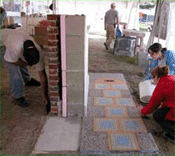 One of the most efficient ways to accomplish this ideal is for schools to partner with experts in the respective materials. Schools that take that approach quickly learn the value of such partnerships.
One of the most efficient ways to accomplish this ideal is for schools to partner with experts in the respective materials. Schools that take that approach quickly learn the value of such partnerships.
The International Masonry Institute (IMI) works with countless recognized universities, professors and instructors of architecture. In its role of "adjunct" masonry instructor, IMI programs enhance existing masonry curriculum with additional lectures, competitions and hands-on learning.
IMI, which is a joint labor/management cooperative trust of the International Union of Bricklayers and Allied Craftworkers (BAC) and signatory contractors, invest millions annually in quality craft training programs in all of the masonry trades. It reaches out to future designers, as well as practitioners, to impart a clear understanding of the benefits of skilled craftsmanship. It is a critical lesson, when the difference between skilled and unskilled workers can literally make or break the best-designed project.
Working with schools has taught IMI something, too. Architecture students get enough general material understanding to spark an interest in academic masonry solutions, but not enough to develop a level of comfort with the material that can follow them into a professional setting.
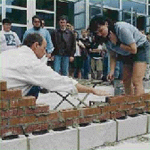 This means that masonry education is often stronger at the professional level, particularly at firms that seek out best practice solutions in masonry. This is great ? at least for those firms ? but where does that leave practitioners in firms without standard masonry details, best practices or protocols? What about the young designers who have chosen to practice architecture in an individual practice with the hopes of establishing their own approach and brand of design? In these cases, what the architect doesn't learn in school can mean a missing skill set.
This means that masonry education is often stronger at the professional level, particularly at firms that seek out best practice solutions in masonry. This is great ? at least for those firms ? but where does that leave practitioners in firms without standard masonry details, best practices or protocols? What about the young designers who have chosen to practice architecture in an individual practice with the hopes of establishing their own approach and brand of design? In these cases, what the architect doesn't learn in school can mean a missing skill set.
A good architecture education is also supposed to develop problem-solving skills that become the basis for creating architectural solutions. The architect is taught to break down the world into components with relationships and associations that can be collected in a delicate arrangement of space, form and function. These spatial relationships are then crafted using an array of materials, each requiring as much understanding as the architectural principals behind the design solution. Because the architect is often expected to have a multi-faceted and diverse working knowledge of materials and systems, true material learning is achieved through the course of work experiences, industry contacts and continuous learning.
The School of Experience
What we didn't learn in school was the value of the entire construction team, the value of pre-project planning and the value of direct craftworker and contractor involvement. All too often, students are (explicitly or implicitly) taught to separate the construction industry from the design industry, building on an inclination "to view architecture as a solitary endeavor," says University of Minnesota Associate Professor of Architecture J. Stephen Weeks.
The barriers created between those who design and those who build leads to a further impediment, when the inability to build what is designed is blamed on the opposite party. A better approach is to flip that supposition on its head, and instead teach architecture students that builders can build what they design, as long as designers understand how those components come together.
One of the designer's greatest skills is the ability to see with his or her hands. Proof of this is the use of modeling to study and solve architectural problems. For the same reason, hands-on masonry learning has proven to be invaluable in understanding the feel of material and modeling real life building solutions.
Making the Connections
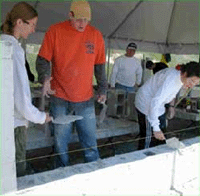 IMI provides universities and professional firms hands-on programs that focus on the issues a designer should continue to remember, practice and learn. Issues like modular building, material understanding, detailing and craft techniques that represent good masonry solutions. Parallel to its craftworker training approach, IMI teaches the craft of masonry to designers through hands-on teaching that allows a better level of comfort and appreciation of the material's potentials.
IMI provides universities and professional firms hands-on programs that focus on the issues a designer should continue to remember, practice and learn. Issues like modular building, material understanding, detailing and craft techniques that represent good masonry solutions. Parallel to its craftworker training approach, IMI teaches the craft of masonry to designers through hands-on teaching that allows a better level of comfort and appreciation of the material's potentials.
At Minnesota, Professor Weeks has students in his introductory classes build small wood frame structures, as well as masonry components. He finds masonry the most challenging.
"Many students have difficulty making the connection between what they are expected to detail on paper and what it looks like in the field, unless they actually do the same work themselves," says Weeks. "Hands-on masonry, wielding a trowel, laying the brick on a bed of mortar, leveling ? all these events quickly and thoroughly immerse [students] in recognizing the need for a strong collaboration in creating design ideas."
Practitioners like IMI "make all the difference," he says.
A little exposure can go a long way. Illinois Institute of Technology Associate Professor of Architecture Arthur Takeuchi last fall had his students attend a couple of sessions at the IMI District Council Training Center, plus a side trip to the Glen-Gery Marseilles Brick Plant.
"Our students got some first-hand experience," he says. "We were very much impressed with how much information and know-how the students were able to absorb in a limited time span."
A Guide to Masonry Fundamentals
- Respect the modular system. Design modularly to provide the best aesthetics and cost efficiencies. This includes floor plan and elevation dimensions.
- Not all masonry materials act the same. Bricks arrive at the job site at their smallest dimension and will expand over time. Blocks arrive at the job site at their largest dimension and shrink over time. Understand how this affects building movement and provide details with movement in mind.
- Understand architectural responsibilities to assure your design intent. For example, architects are required by code to indicate and locate all movement joints on the drawings. Placement of movement joints should be clearly indicated in all brick masonry.
- Avoid masonry problems by providing consistent drawing information. Scrutinize architectural, structural, mechanical, and other project drawings and specifications for inconsistencies or problems with cross-referencing.
- Study the details. Include flashing at water penetration points, such as at the base of walls, windows and door openings, tops of walls and shelf angles.
- Understand the full masonry package. Cross-reference drawings to specifications. Recognize that project specifications not only supplement the drawings, but often contain critical information that can override drawing information.
- Identify structural uses. Clearly provide information on reinforcing and/or grouted masonry.
For further assistance, IMI provides a host of technical services, from detailing consultations and project review to job site troubleshooting, plus craft training in all the masonry trades and specialties. IMI can be reached at (800) IMI-0988.
"It Should be Required"
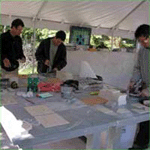 Nothing illustrates the value of a quick, but intense, immersion into materials study ? and the need for collaboration ? more dramatically than IMI's Masonry Camp. In just one week, architectural interns and graduate students team-up with apprentice BAC craftworkers on a design/build challenge that emphasizes role reversal. At the same time, they spend half a day studying and working with each masonry material: brick, block, stone, tile, terrazzo and plaster. That one week makes a big difference.
Nothing illustrates the value of a quick, but intense, immersion into materials study ? and the need for collaboration ? more dramatically than IMI's Masonry Camp. In just one week, architectural interns and graduate students team-up with apprentice BAC craftworkers on a design/build challenge that emphasizes role reversal. At the same time, they spend half a day studying and working with each masonry material: brick, block, stone, tile, terrazzo and plaster. That one week makes a big difference.
"The lessons I learned here will stay with me for the remainder of my career," says 2002 Camper David Rivera of Cannon Design in New York City.
Portland architect Jeff M. Yrazaba says it made him contemplate that "we all are more alike than we realize, and when we put our minds together good things happen."
Boston architect Kim Elliot from Perry Dean Rogers Partners Architects is unequivocal on the need for such experiences, especially at the start of a career.
"Every architecture student or intern should be required to come to Masonry Camp," states Elliot.
Teaching architects while they are "young," professionally speaking, also provides a golden opportunity to impress upon them that a working marriage of design, technology, constructability and durability/performance is not just wishful thinking, but with the right mindset is eminently achievable.
"Too often, students are programmed to think that what they design cannot be built," says architect Julie Eizenberg of Koning Eizenberg Architecture in Santa Monica, Calif. "They need to be aware of both ends of the process ? design and construction ? to better meet their building goals."
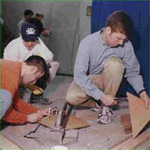 "Constructing the detail and knowing that it is crafted as part of a larger design element bridges the gap between design conception, where students spend the majority of their academic efforts, and the building activity," says Weeks. "It is a form of rehearsing the construction sequence in order to understand exactly how to create the detail."
"Constructing the detail and knowing that it is crafted as part of a larger design element bridges the gap between design conception, where students spend the majority of their academic efforts, and the building activity," says Weeks. "It is a form of rehearsing the construction sequence in order to understand exactly how to create the detail."
For professionals, the construction sequence can be rehearsed and improved by attention to opportunities built through industry partnerships, pre-project planning meetings, and direct craftworker and contractor involvement.
Esteemed architects have earned their reputations by understanding that physical material components in an ordinary wall section deserve as much respect as the programmatic components that drive spatial requirements. Yet the road from the world of education to the world of applied practice relies on little more than a leap of faith that we will ? someday, somehow ? achieve material understanding.
What Do You Want to Know?
The thirst for masonry education continues well after school. A sampling of requests made to IMI technical services staff provides a window into the issues interesting to today's practitioners. These include:
- Air barriers
- Allied craft materials and installation issues (tile marble, stone, terrazzo, plaster, cement)
- Codes
- Flashing and water penetration
- Fire safety
- Mold
- Movement joints
Just Ask
What is left unsaid in school is the value of finding and developing industry resources that can enhance our architectural design abilities, and filling in those gaps of material expertise.
At the Hillier Group in Princeton, N.J., firm directors realized the importance of teaching their young architects proper technical and masonry knowledge. So Hillier turned to IMI for a concentrated "crash course." IMI's unique combination of craftworkers, contractors and technical consultants combined forces for a custom "Masonry Day" that included lectures and hands-on exposure to masonry materials, plus the opportunity to see skilled craftworkers in action.
Continuing education for design and construction professionals at all stages of their careers is a core part of IMI's mission of quality union masonry. At ARCADIS Giffels, a top manufacturing and industry design firm based in Michigan, IMI designed a monthly technical seminar series tailored to their project needs, from prisons to restoration. Even the firm's clients are taking advantage of it.
"It's right on target," says coordinator Ken Livingston, AIA. "I don't see any other trade working as hard to improve skills."
When the second largest overall design firm in the United States thought it needed to learn more about masonry, it turned to IMI and got a custom-tailored program of technical seminars, demonstrations and hands-on exposure to the full range of masonry materials More than 150 staff architects, engineers and interior designers, plus some building owners and other guests spent a day at "IMI University," learning about stone, marble, terrazzo, grouting, prestressed systems, code changes, cavity wall design and construction, and aerated autoclaved concrete (AAC).
At NBBJ, the world's third largest architectural firm, IMI convened training and technical staff plus BAC officials, contractors and suppliers in Columbus, Ohio, to deliver technical seminars and hands-on craft demonstrations of tile, terrazzo, brick, block and stone, to show firm members how their designs get translated into reality. The effort was extended to appreciative area architects and architectural students the following day.
Variations of these "Masonry Day" events occur throughout the country, as practitioners seek the experts who can fill-in the blanks. In the end, good buildings and good designs simply do not spring from a single talent, but instead from a team of talents each contributing his or her expertise. So, when it comes to understanding materials, doesn't it make sense to seek expertise from those people who use them on a daily basis?
This is particularly true for younger, and young-minded, designers contemplating "futuristic" materials. Few if any students of architecture stop to think that such "futuristic" thinking about materials is often first explored by the craftworker. Therefore, on a search for new design possibilities, the craftworker should be invited.
"That is what creates the real value," says University of Notre Dame Professor Don Sporleder. "Teamwork is absolutely required. Building is itself an art and a craft."
Look to the Craft
A look at the education and experience of the craftworker dramatically illustrates what the designer needs to learn. Much like the craft of architecture, the craft of masonry is based on rules and guidelines that address properties, proportions and technique. And much like the study of architecture, the study of masonry begins with fundamental understanding of unit sizes, movement characteristics, possible (and impossible) variations and the tools.
Then there are the materials themselves. Masonry includes a family of trowel-applied materials: brick, stone, tile, terrazzo, marble, cement and plaster, as well as the restoration arts for all of them. To truly be a master of masonry design means understanding both materials and their constructability, so as to develop the expertise to incorporate the various materials in a way that is creative, aesthetic and functional.
Amazingly, for all its historical significance, masonry's potential is still often overlooked on campuses. A key example of this is masonry's value as a structural material. Fortunately, that recognition is more common among practitioners, notes IMI Director of Program Development Maria Viteri, AIA. Structural masonry is prevalent, largely because it is competitive with other materials' schedules, and it is even showing up with greater frequency in architectural awards. Yet in design school, she says, "it is still being taught as a veneer system. That's unfortunate, when there is so much more out there."
About the Author
Hazel Bradford is director of communications for the International Masonry Institute (IMI) and a former Washington correspondent for McGraw-Hill and ENR magazine.. The IMI is a strategic alliance of the International Union of Bricklayers and Allied Craftworkers and their signatory contractors, providing skilled craft training and technical assistance to the design and building communities.


















